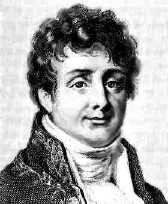 |
| "The differential equations of the propagation of heat express the most general conditions, and reduce the physical questions to problems of pure analysis, and this is the proper object of theory." |
| Joseph Fourier (1768 - 1830) |
|
Jean Baptiste Joseph Fourier (March 21, 1768 - May 16, 1830) was a French mathematician and physicist who is best known for initiating the investigation of
Fourier series and their application to problems of heat flow. The Fourier transform is also named in his honor.
Fourier was born at Auxerre in the Yonne département of France, the son of a tailor. He was orphaned at age eight. Fourier was recommended to the Bishop of
Auxerre, and through this introduction, he was educated by the Benedictines of the Convent of St. Mark. The commissions in the scientific corps of the army were
reserved for those of good birth, and being thus ineligible, he accepted a military lectureship on mathematics. He took a prominent part in his own district in
promoting the revolution, and was rewarded by an appointment in 1795 in the École Normale Supérieure, and subsequently by a chair at the École Polytechnique.
Fourier went with Napoleon on his Eastern expedition in 1798, and was made governor of Lower Egypt. Cut off from France by the English fleet, he organized the
workshops on which the French army had to rely for their munitions of war. He also contributed several mathematical papers to the Egyptian Institute which Napoleon
founded at Cairo, with a view of weakening English influence in the East. After the British victories and the capitulation of the French under General Menou in 1801,
Fourier returned to France, and was made prefect of Isère, and it was while there that he made his experiments on the propagation of heat.
Fourier moved to Paris in 1816. In 1822 he published his Théorie analytique de la chaleur, in which he bases his reasoning on Newton’s law of cooling, namely,
that the flow of heat between two adjacent molecules is proportional to the extremely small difference of their temperatures. In this influential work on heat conduction
Fourier discovered a way to present any arbitrary function as a series of sines. Although not thoroughly formal from today’s perspective, his work has
no less than gigantic and revolutionary impact on mathematics, physics, engineering and other spheres of science. Using Fourier transformation scientists and engineers
are able to determine chemical content of stars and other celestial objects and gases in atmosphere. Fourier transformation is widely used also in acoustics, optics,
signal and image processing, metal detecting and others.
Fourier died in Paris in 1830.
Fourier left an unfinished work on determinate equations which was edited by Claude-Louis Navier and published in 1831. This work contains much original matter — in
particular, there is a demonstration of Fourier’s theorem on the position of the roots of an algebraic equation. Joseph Louis Lagrange had shown how the roots of an
algebraic equation might be separated by means of another equation whose roots were the squares of the differences of the roots of the original equation. François Budan,
in 1807 and 1811, had enunciated the theorem generally known by the name of Fourier, but the demonstration was not altogether satisfactory. Fourier’s proof is the same
as that usually given in textbooks on the theory of equations. The final solution of the problem was given in 1829 by Jacques Charles François Sturm.
Fourier is also credited with the discovery in his essay in 1824 that gases in the atmosphere might increase the surface temperature of the Earth. This was the effect
that would later be called the greenhouse effect. He established the concept of planetary energy balance - that planets obtain energy from number of sources that causes
temperature increase. Planets also lose energy by infrared radiation (that Fourier called "chaleur obscure" or "dark heat") with the rate increasing with temperature.
A balance is reached between heat gain and heat loss; the atmosphere shifts the balance toward the higher temperatures by slowing the heat loss. Although Fourier
understood that rate of infrared radiation increases with temperature, the Stefan-Boltzmann law which gives the exact form of this dependency (a fourth-power law) was
discovered fifty years later.
Fourier recognized that Earth primarily gets energy from Solar radiation, to which the atmosphere is transparent, and that geothermal heat doesn’t contribute much to
the energy balance. However, he mistakenly believed that there is a significant contribution of radiation from interplanetary space.
Fourier referred to an experiment by M. de Saussure who exposed a black box to sunlight. When a thin sheet of glass is put on top of the box, the temperature inside
of the box increases. Infrared radiation was discovered by William Herschel only twenty five years later.
This article is licensed under the GNU
Free Documentation License. It uses material from the Wikipedia article "Joseph Fourier".
|